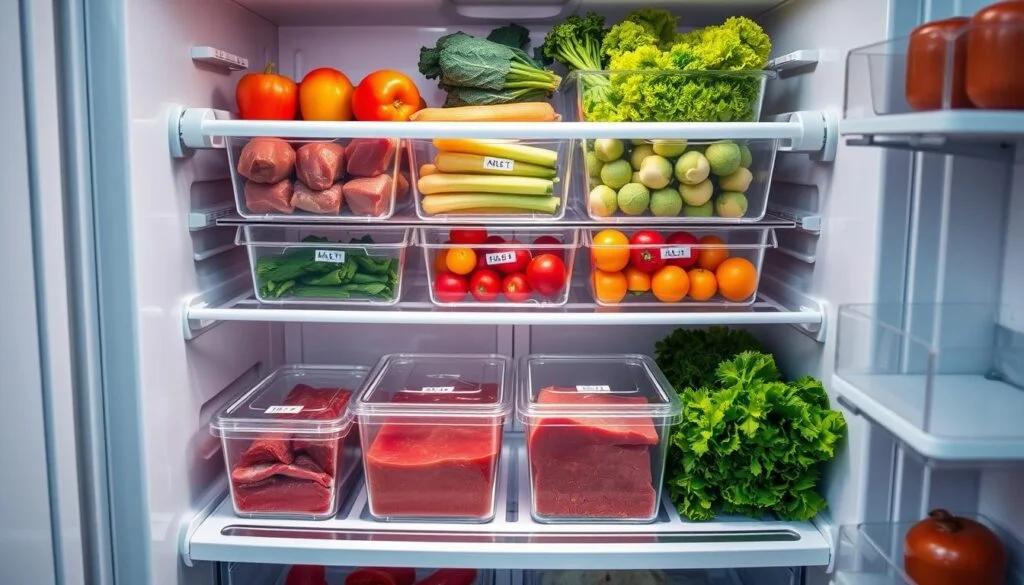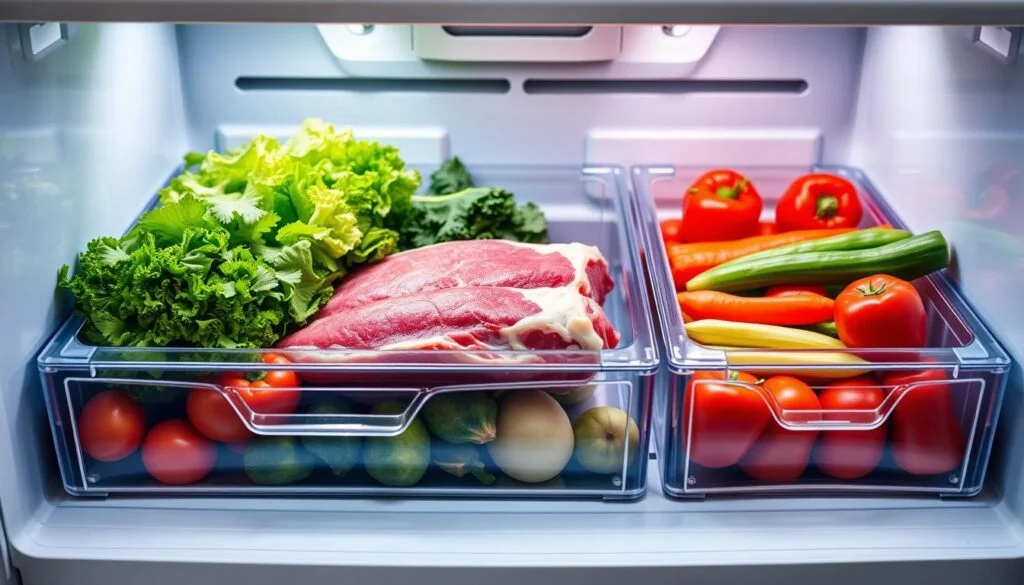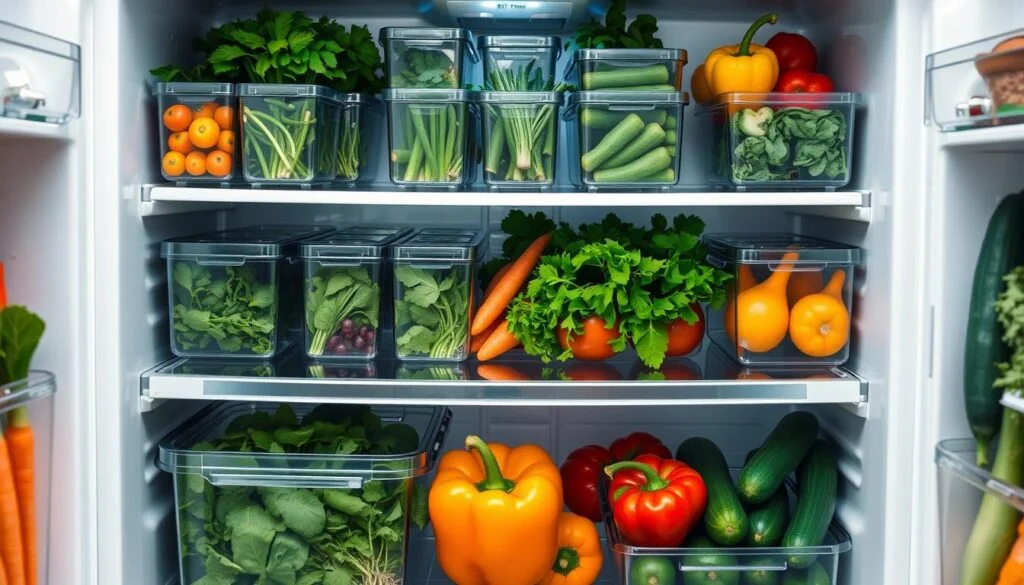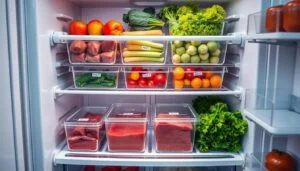Keeping your food fresh and safe is key when storing it in the fridge. This is especially important for raw meat and veggies. If you don’t store them right, you could spread germs and risk getting sick. In this guide, we’ll show you how to store these foods safely in your fridge.

Storing food correctly helps keep it fresh and stops harmful bacteria from spreading. Knowing how to store food right is crucial. It helps avoid risks like cross-contamination. This article will teach you how to keep your fridge organized and your family healthy.
The Importance of Proper Food Storage
Storing food right is key for food safety, stopping cross-contamination, and keeping your food fresh. It doesn’t matter if it’s raw meat or veggies. Knowing how to organize your fridge can really help keep your food safe and fresh for longer.
Preventing Cross-Contamination
Keeping food stored properly is mainly to stop cross-contamination between raw meat and veggies. If these two mix, bacteria from the meat can spread to the veggies. This can lead to foodborne illnesses. By storing them apart, you greatly lower the chance of contamination and keep your family healthy.
Maintaining Food Quality and Freshness
Right food storage also helps keep your food’s quality and freshness up. The right temperature and humidity can make your produce last longer. This means you get more value from your groceries, save money, and help the environment.
Learning about proper food storage and following the best methods can make your fridge tidy, your family safe, and your meals fresh for longer. The next part will explore the different temperature zones in your fridge and how to use them best.
“Proper food storage is the foundation of a safe and healthy kitchen.”
Understanding Temperature Zones in Your Fridge
Storing food safely means knowing your fridge’s temperature zones. Fridges have different parts for keeping food fresh. This helps prevent food from going bad.
The top shelf is the warmest spot. It’s best for things like drinks, condiments, and leftovers. The middle shelves are cooler. They’re great for raw meat, poultry, and fish to stay safe and good.
The bottom drawer is perfect for keeping fruits and veggies fresh. It keeps the air moist. This helps your produce stay crisp and full of nutrients.
To keep your fridge organized, learn about its temperature zones. Check your owner’s manual or the manufacturer’s website. They’ll tell you where to store different foods.
- Top shelf: Beverages, condiments, and leftover containers
- Middle shelves: Raw meat, poultry, and fish
- Bottom drawer: Fresh fruits and vegetables
Using your fridge’s temperature zones helps keep food fresh and safe. It makes your food taste better for longer. And it helps avoid foodborne illnesses and waste.
Separating Raw Meat from Vegetables
It’s important to keep raw meat and vegetables separate to avoid cross-contamination. This helps keep your food safe. When you store them in the fridge, follow the best practices to stop harmful bacteria from spreading.
Avoiding Cross-Contamination Risks
Cross-contamination happens when bacteria from raw meat get on other foods, like veggies. This can cause harmful pathogens to grow. This increases the risk of getting sick from food. Here are some ways to lower these risks:
- Put raw meat on the bottom shelf of the fridge, below the veggies. This stops drips from getting on the produce.
- Use different cutting boards and tools for raw meat and veggies. This stops them from touching each other.
- Clean and sanitize all surfaces that touched raw meat before using them for other foods.
- Wrap or cover raw meat to stop juices from leaking and getting on other foods.
By taking these steps, you can keep raw meat and veggies separate. This greatly reduces the risk of cross-contamination. It helps make sure your meals are safe and healthy.
Keeping raw meat and veggies properly stored and handled is key. It helps keep food quality high, prevents sickness, and makes sure meals are safe and healthy for everyone.
Where in the Refrigerator Should You Store Raw Meat with Vegetables
Keeping your fridge organized is key to avoiding cross-contamination. It also helps keep your food fresh and safe. Knowing where to put raw meat and veggies is important to avoid food poisoning.
The bottom shelf is the coldest part of your fridge. It’s best for raw meat. This way, any spills won’t reach other foods. Meanwhile, veggies and ready-to-eat foods go on the top shelves. They stay a bit warmer, which helps avoid contamination.
| Refrigerator Zone | Ideal Food Storage |
|---|---|
| Bottom Shelf | Raw Meat |
| Upper Shelves | Vegetables, Ready-to-Eat Foods |
By organizing your fridge this way, you can stop cross-contamination. This keeps your food safe and fresh. Remember, a clean fridge is a healthy home for your family.

“Proper refrigerator storage is essential for food safety and quality. Keeping raw meat separate from vegetables can help prevent cross-contamination and reduce the risk of foodborne illnesses.”
Meat Storage: Best Practices
Storing meat properly is key to keeping it fresh and safe. To keep your raw meat fresh and free from bacteria, follow some important steps.
Choosing the Right Containers
Choosing the right container for raw meat is important. Use airtight, leak-proof containers or resealable bags to keep meat fresh. Stay away from materials like wood or unlined cardboard, as they can spoil meat.
Handling Raw Meat Safely
Handling raw meat safely is crucial to avoid foodborne illnesses. Always wash your hands with soap and water before and after touching raw meat. Use different cutting boards and utensils for raw meat and other foods to prevent contamination. Also, make sure to cook meat to the right temperature to kill bacteria.
| Meat Type | Recommended Internal Temperature |
|---|---|
| Ground Meat | 160°F (71°C) |
| Steak, Roasts, and Chops | 145°F (63°C) for medium rare, 160°F (71°C) for medium |
| Poultry | 165°F (74°C) |
By following these meat storage and handling tips, you can keep your raw meat safe and of high quality. This reduces the risk of foodborne illness and keeps your meals tasty and fresh.
Vegetable Storage: Tips and Tricks
Keeping your vegetables fresh is key. By using simple tips, you can keep your produce crisp and tasty. Here are the best ways to store vegetables for top food quality and freshness.
Maximizing Freshness and Nutrition
To keep your vegetables fresh and nutritious, try these:
- Put veggies in the right spot in your fridge, usually the crisper drawer. This helps them stay fresh and crunchy.
- Wrap leafy greens in a damp paper towel or use a bag with holes. This keeps them moist and prevents them from drying out.
- Keep fruits like apples and tomatoes away from vegetables. They give off gases that can make veggies ripen too fast.
- Don’t pack your fridge too tight. This stops air from moving and can make veggies spoil faster.
By doing these things, you can keep your vegetables fresh and full of flavor. This way, you get to enjoy the health benefits of fresh produce for longer.

“Proper storage is the key to maintaining the quality and nutritional value of your vegetables.”
Organizing Your Fridge for Optimal Storage
Keeping your fridge organized is key to food safety and better storage. By arranging your fridge smartly, you can keep raw meat and veggies separate. This helps avoid contamination and keeps your food fresh and quality high.
Using special storage areas in your fridge is a big help. Modern fridges have sections for different foods, like a meat drawer or a crisper for veggies. These areas help you store dangerous items like raw meat away from delicate produce.
| Refrigerator Compartment | Ideal Food Storage |
|---|---|
| Meat Drawer | Raw meat, poultry, and fish |
| Crisper Bin | Fruits and vegetables |
| Top Shelf | Cooked leftovers, dairy products |
| Door Shelves | Condiments, beverages, and items with shorter shelf lives |
It’s also crucial to keep raw meat and veggies apart in your fridge. Storing them on different shelves or in separate containers helps prevent contamination. This keeps your food safe.
Proper refrigerator organization is not just about being organized. It’s also vital for food safety. By following these tips, you can set up a system that keeps your raw meat and vegetables apart. This helps maintain the quality and freshness of your food.
Cleaning and Maintaining a Safe Refrigerator
Keeping your refrigerator clean and organized is key for food safety. Regular cleaning stops harmful bacteria from growing. This helps prevent foodborne illnesses. By following best practices, your fridge stays a safe place for your food.
Preventing Foodborne Illnesses
Cleaning your fridge is crucial to stop foodborne illnesses. Bacteria like Salmonella and E. coli can grow in a dirty fridge. This can make your food unsafe. Cleaning and disinfecting your fridge kills these bacteria, keeping your food fresh and safe.
To keep your fridge clean, use a mild soap or baking soda solution. Clean shelves, drawers, and door seals to remove spills. Also, throw away any expired or spoiled food to stop bacteria from spreading.



